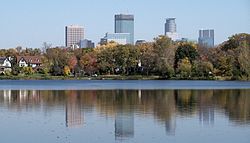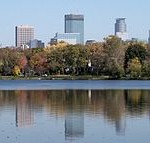
For LGBT people, the climate in Minneapolis is good. A large community, safe schools, mostly equal rights, and supportive community leaders and institutions have made it a city LGBT people can take pride in.
(In April, Minneapolis Mayor Betsy Hodges announced that the week of July 14-20 would be the First Best Week of Bragging About Minneapolis Ever, an effort to cast aside our collective aversion to bragging and start telling the world why Minneapolis is one of the best places to be. TheColu.mn is honoring First Best Week of Bragging About Minneapolis Ever with a series about why Minneapolis is a great place for LGBT people.
It’s still not perfect, but Minneapolis has a lot to brag about. This is the second part in a five part series.)
8. Minneapolis has a lot of LGBT people!
Knowing you have community support is important, and the city has a large population of LGBT people. Minneapolis ranks 4th in the nation with 12.5 percent of the population identifying as lesbian, gay, or bisexual according to a 2006 composite of data from the American Community Survey.
The Minneapolis-St. Paul metropolitan area ranked 15th for same-sex couples raising children.
In an analysis by UCLA’s Williams Institute, Minneapolis ranked 4th in the nation for number of same-sex couples per capita at 21.74 per 1,000 residents.
7. Minneapolis is often rated as one of the gayest in the country
Minneapolis consistently ranks among the gayest or most LGBT-friendly cities. In 2011, the Advocate named Minneapolis the gayest city in America prompting a Daily Show spoof.
Other self-appointed gay city rankers have us in the top 10. In 2014, Nerd Wallet ranked Minneapolis the 6th LGBT friendly city in the country (St. Paul got 9th). Nerd Wallet ranked percentage of same-sex couples, relative safety for LGBT residents, and LGBT friendly laws.
Cheapflight.com ranked Minneapolis 4th on its list of top 10 places to celebrate gay rights.
6. City leaders have made Minneapolis an incredibly inclusive place for LGBT people
The Human Rights Campaign gives Minneapolis a perfect 100 out of 100 on its Municipal Equality Index which counts things such as relationship recognition, city employment, law enforcement inclusiveness, and school safety. Minneapolis was the first city in the nation to pass a ban on discrimination based on sexual orientation and gender identity.
Minneapolitans are also protected by Minnesota’s progressive state government which outlawed discrimination based on sexual orientation and gender identity in 1993. It was the first state to do so.
5. Minneapolis has marriage equality
Same-sex couples in Minneapolis can get legally married as of August 2013. Former Mayor RT Rybak officiated dozens of same-sex weddings in a marriage-marathon when marriage equality became legal.
And Minneapolis’ elected leaders are proud to export equal rights. Mayor Rybak did a tour of the Midwest encouraging those in states without marriage equality to come to Minneapolis to marry.
Mayor Betsy Hodges officiated the wedding of a South Dakota couple in May so that the couple could go back to their home state and sue for equality.
Minneapolis city officials have fought hard for rights for same-sex couples. The city used to offer domestic partner benefits in the 1990s, but a lawsuit by a conservative Christian halted those rights. Still, city leaders instituted a domestic partner registry to help same-sex couples get benefits from their employers.
4. Minneapolis public schools work to protect their LGBT students
In the early 1990s, Minneapolis Public Schools created Out for Good, a program to support LGBT programs which included a safe and supportive staff program for LGBT youth. The school district beefed up its commitment to anti-bullying in 2011 and made improvements to the climate for trans* and gender nonconforming students.
And this spring, the Minnesota Legislature passed a comprehensive anti-bullying law that includes protections for LGBT youth.
3. Minneapolis has a remarkable trans* community.
The World Professional Association for Transgender Health, Inc. (WPATH) is based in Minneapolis. WPATH “brings together diverse professionals dedicated to developing best practices and supportive policies worldwide that promote health, research, education, respect, dignity, and equality for transsexual, transgender, and gender nonconforming people in all cultural settings.” WPATH has developed the Standards of Care for trans* and gender nonconforming people and has been a leader in the movement to eliminate the view that gender variance is a pathology.
The work of WPATH, along with the Minnesota Transgender Health Coalition, the Trans Youth Support Network, the University of Minnesota’s Program in Human Sexuality, the Gender Education Center, the Trans* Awareness Project, and the City of Lakes Crossgender Community, among others, have worked to make Minneapolis a more welcoming, inclusive, and safe city for trans* and gender nonconforming people.
Community trailblazers that call Minneapolis home include LGBT elder advocate Barbara Satin, LGBT youth advocate Katie Burgess, artist and poet Andrea Jenkins, community organizer Roxanne Anderson, former school librarian Debra Davis, and Cece McDonald, who fought back against transphobic and racist violence. And there are many, many others in the trans* community who are making Minneapolis a better city.
2. Minneapolis-based businesses support the LGBT community
A whopping 15 of the Human Rights Campaign’s best places to work are in Minneapolis or surrounding communities.
General Mills’ Betty Crocker baked cakes for same-sex couples when marriage equality became legal in August 2013. Target launched a line of Pride t-shirts in select Minneapolis stores. The head of RBC Wealth Management fought against a damaging anti-gay marriage amendment. Best Buy, General Mills, US Bank, and Target are among the Minneapolis businesses sponsoring Pride every year
1. Minneapolis has no gayborhood
Wait. Why is that a good thing? Because in Minneapolis, every neighborhood is a gayborhood.
Historically, the Gateway District in downtown Minneapolis (near the Gay 90s) was considered the first “gay ghetto.” Loring Park was considered the city’s gayborhood for decades, and Twin Cities Pride is still held there.
In the mid-2000s, there was a rumor that Mayor RT Rybak was looking at Central Avenue in Northeast Minneapolis as a new “gayborhood” as four new LGBT bars sprung up in the area. Many LGBT people call Northeast home with its microbreweries, thriving arts scene, and distinct Eastern European influences.
LGBT families have been lured to North Minneapolis by affordable housing prices and a thriving community has developed there. In 2009, Lavender Magazine labelled North Minneapolis as the city’s best gayborhood.
Minneapolis’ Uptown neighborhood has long been a haven for bohemians, punks, and hippies — and, of course, a large LGBT population.
South Minneapolis has been a great place for LGBT couples and families to buy homes and raise kids.
Previously: Bragging on Minneapolis: The top 10 ways the city made LGBT history
